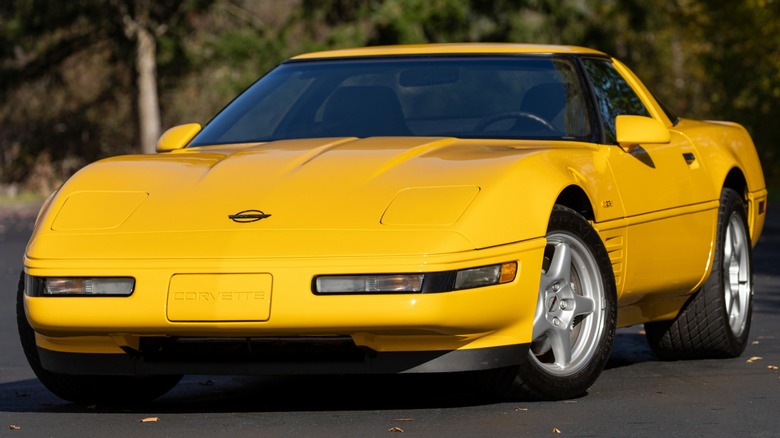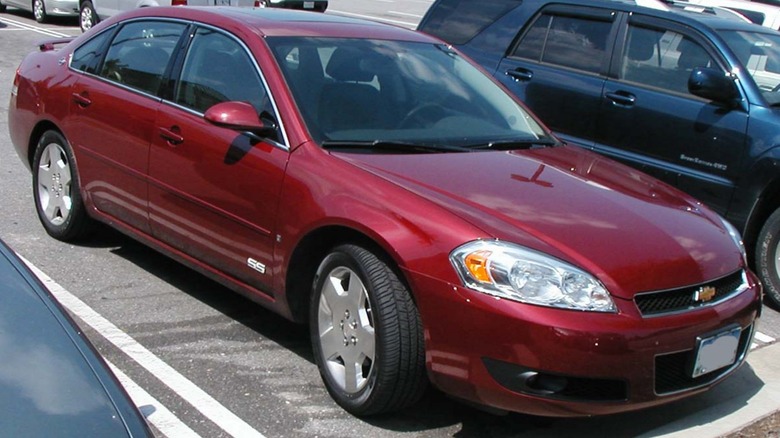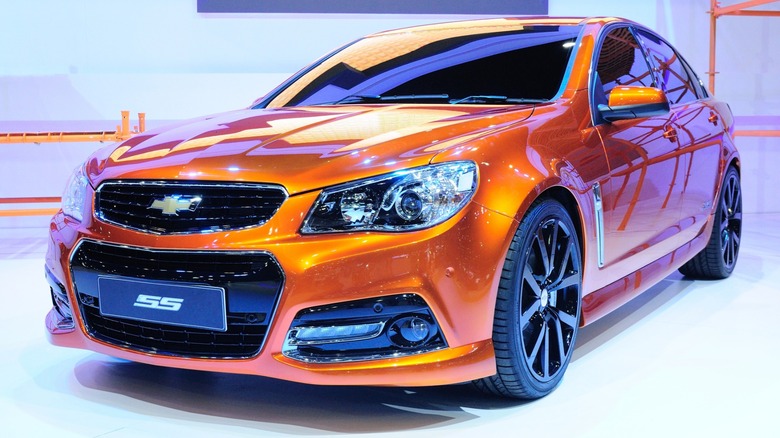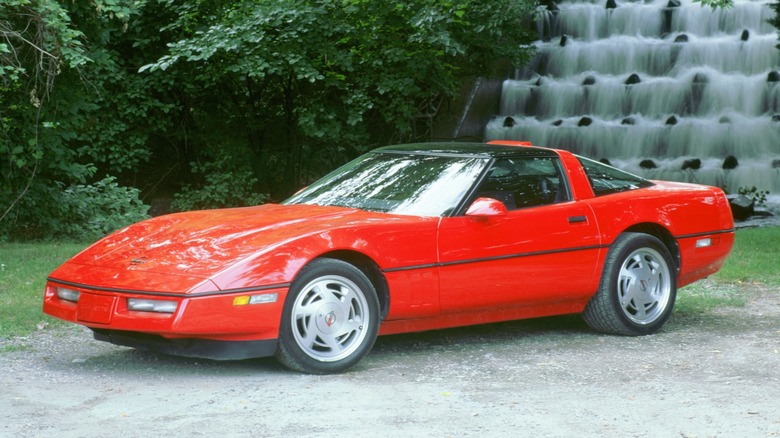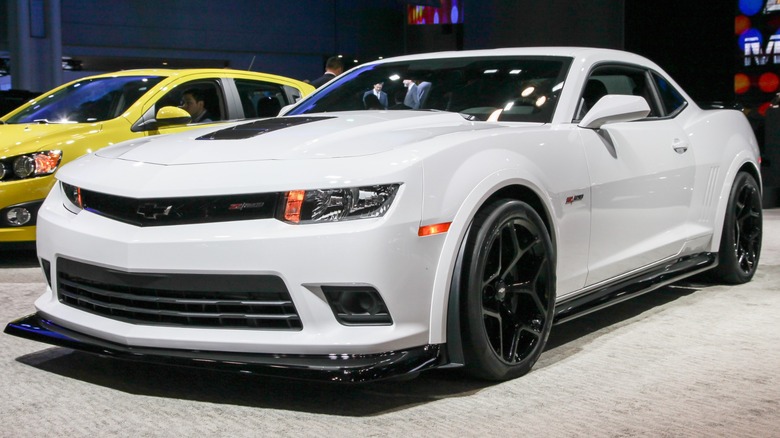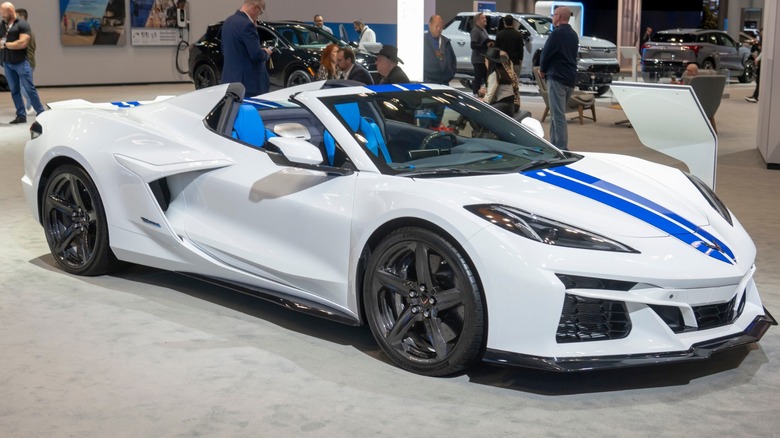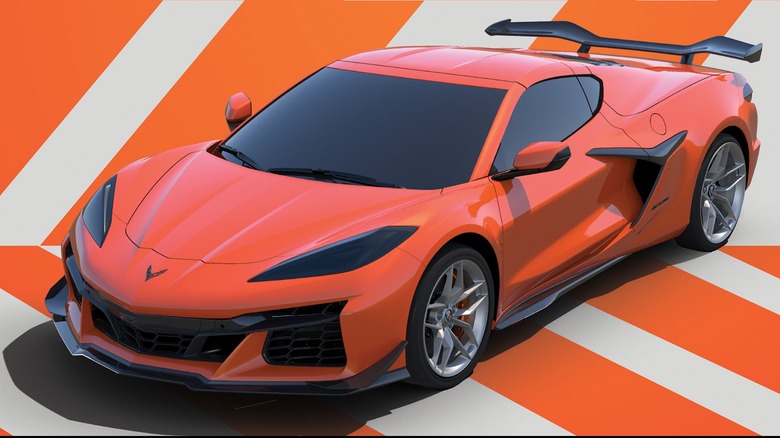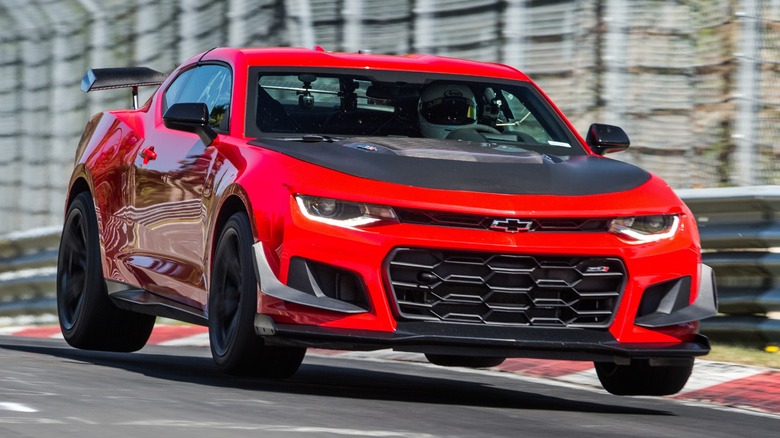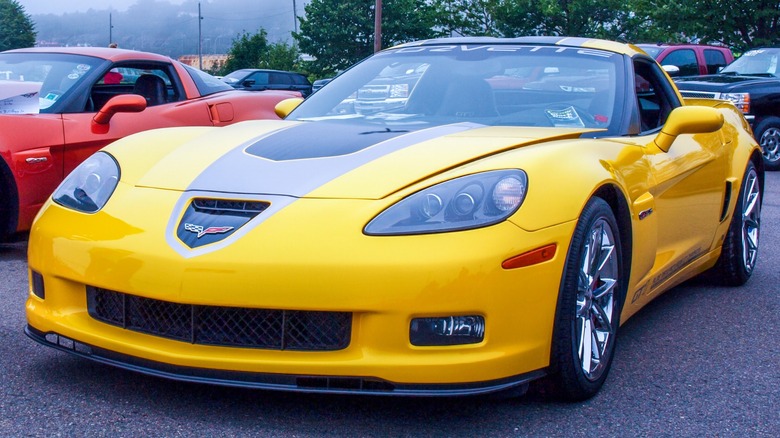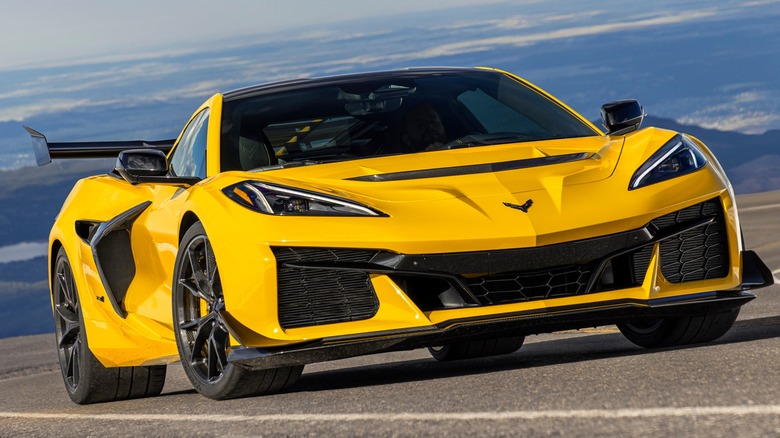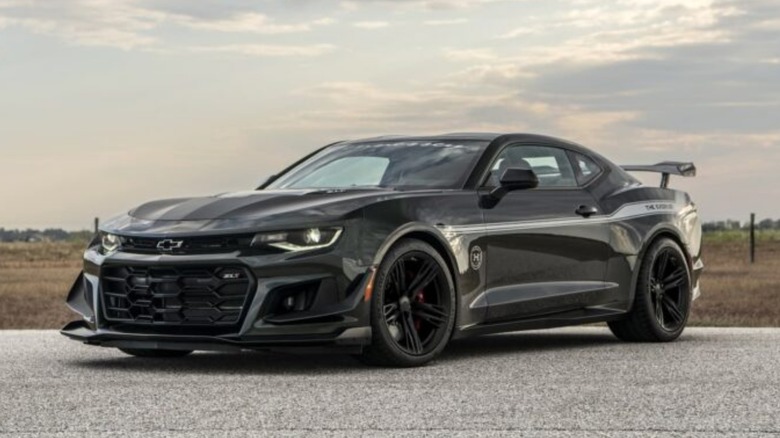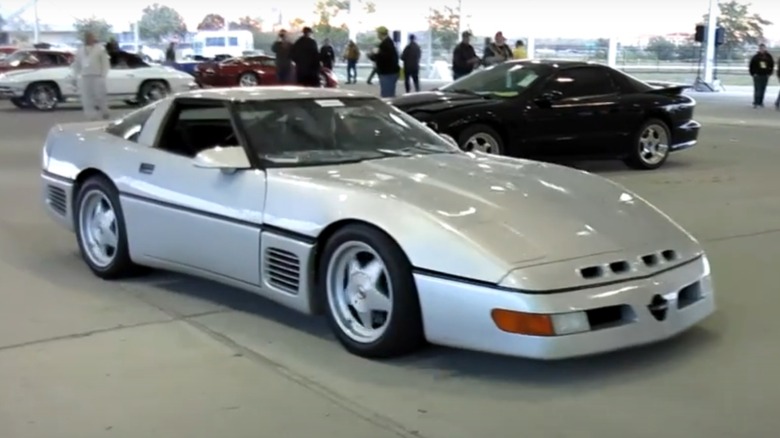11 Of The Fastest Chevrolet Cars Ever Made, Ranked By Top Speed
In its early days after being acquired by General Motors, Chevrolet positioned itself as a low-cost option competing with Ford, vying for consumers looking for basic and affordable transportation. Low-cost automobiles for the masses continued to sustain the brand through to the post-war period, leaving fancier and higher performing cars to its stablemates within the GM hierarchy. However, Chevrolet's brand image changed the day it introduced the C1 Corvette to dealerships in 1953, and a full transformation concluded after the small-block Chevy V8 debuted a couple of years later in 1955. From then until today, Chevrolet has been a name synonymous with high speed.
In the post-war era, Chevrolet has set many benchmarks for performance. Beginning with the fuel-injected 1957 Corvette, each successive generation of Chevrolet models have included cars that push the boundaries without the exorbitant price tags of European exotics. Some highlights of performance over the years include the the sophisticated IROC-Z Camaro of the '80s and the 1969 COPO Camaro ZL1 and 1970 Chevelle SS 454 LS6 of the muscle car era while the modern day has brought Chevrolet models with previously unheard of performance, particularly for regular production models. Furthermore, the top speed of these brilliant and often iconic machines rises higher with each generation, and these 11 Chevrolet models are the fastest produced to date.
2006 Chevrolet Impala SS - 154 mph
Nobody argues that the ninth-generation Chevrolet Impala is the epitome of sports car design and engineering. Nor would it rank among many lists of desirable classics. Nonetheless, with this generation of Impala came the final iteration of Impala SS, and it went out with a bang. When the Impala badge was affixed to a front-wheel-drive platform with the eighth-generation, a high-performance SS model accompanied the boring family sedans to the dealer. However, its supercharged V6 was limited to just 240 horsepower. To remedy that situation, the next SS received a proper V8 to hook the front wheels up to the pavement.
With the V8, this Impala delivered 303 horsepower to the front wheels along with 323 lb-ft of torque steer. The power was generous thanks to the LS4 engine, but the car was flawed elsewhere. Chevrolet essentially stuck its LS V8 into the front of an ordinary Impala. With no suspension upgrades, specialty brakes, or custom bolstered seats, handling was lackluster and cornering soft. Furthermore, the styling of this Impala generation is a demonstration of bland as only GM of the era could do, and its blandness is overshadowed only by the cheapness of the interior plastics.
All disappointment aside, the LS V8 was good for one thing. It provided the last Impala SS a top speed of 154 mph, a highlight of an otherwise dull performance car.
2017 Chevrolet SS - 160 mph
Before sedans disappeared from domestic car lineups and dealerships became plagued with an onslaught of dull SUVs, Chevrolet dug deep into its vast resources for an exciting sports sedan that could competently go up against the likes of BMW and Mercedes in the sports sedan segment, and for a significantly reduced price. Resurrecting a model that had once been badged as the 415-horsepower Pontiac G8 GXP, Chevy went down under to bring the Australian Holden Commodore stateside for one last run before the Aussie division was closed entirely.
While the SS production originated in a factory near Adelaide, it was powered by an American-designed LS V8. This 6.2-liter engine is also good for 415 horsepower and backed by a 6-speed manual transmission, providing a 0-60mph time of just 4.7 seconds and a top speed of 160 mph. Furthermore, the generous power can be enjoyed in upscale surroundings of leather trim with a central touchscreen and bright and distinctive analog gauge cluster. With a few Alcantara accents among the leather, polished aluminum trim, and appealing interior design, nobody would mistake the SS for being a European luxury car, but they would hardly complain spending time in it, either.
Matching the powerful engine is an understated but stylish exterior accented nicely by five-spoke aluminum wheels completing the package. Unfortunately, it failed to bring droves of buyers to the showroom, making the 12,294 Chevrolet SS sold relatively rare in the United States today.
1990 Chevrolet Corvette ZR-1 - 175 mph
While it was once said that "there's no replacement for displacement" for increased power, the new paradigm of the Chevrolet Corvette unveiled in 1990 proved computer controls with fuel injection and better engineering could indeed replace displacement and produce generous horsepower with cleaner emissions. This culminated for Chevrolet in its near-exotic Corvette ZR-1. Thanks to engineering input from Lotus, a reworked small-block 350 received quad-cams sitting atop 32 valves on aluminum heads for an flat-plane crankshaft V8 built by a boat engine manufacturer in Stillwater, Oklahoma called Mercury Marine. The results were astounding. Officially rated at 405 horsepower by 1993, the ZR-1 finally brought power output above 400 for the first time since the early '70s.
With a substantial power boost over the 250-horsepower Corvette of the day, the ZR-1 also came with a hefty price increase. At $58,995 in 1990 dollars, this car was incredibly expensive, representing a premium of $27,016 over a base model. But with that premium came exclusivity, incredible acceleration, and the opportunity to run it out to its incredible 175-mph top speed.
2015 Chevrolet Camaro Z/28 - 175 mph
Before becoming an icon of American automotive style and performance, Z28 was merely a production order code for Chevy dealers. When submitting this Regular Production Option code on a manufacturing order, customers received the then-new 1967 Camaro equipped with a small-block 302 V8 built to satisfy Trans-Am racing regulations. These first cars came with a Z/28 fender badge, and the designation became a high-performance trim level no longer tied to any racing series in 1970.
In the following years, the Z/28 option came and went a few times until the Camaro model was ultimately discontinued altogether after the 2002 model year. But in 2007, a new bright yellow Camaro starred as Bumblebee in the blockbuster "Transformers" movie, foreshadowing the return of Camaro to dealers in 2009 (as 2010 models).
Only in 2014 did the Z/28 option reappear, only to be discontinued again after 2015. However, the car bestowed upon society by the corporate gods of GM was a runner. With a huge 505-horsepower 7.0-liter LS7 V8 shared with the Corvette, the last Z/28 in 2015 was capable of reaching 175 mph. Furthermore, its stellar performance was tamed by an advanced suspension with carbon-ceramic brakes exclusive to the Z/28 and complemented by premium interior components. It is a fitting sign-off for this hallowed American performance car.
2024 Chevrolet Corvette E-Ray - 183 mph
When the 2020 C8 Corvette broke cover, it sent shockwaves as it delivered the mid-engine Corvette teased ever since the unveiling of Corvette designer Zora Arkus-Duntov's innovative 1970 XP-882 prototype. The initial specifications of the C8 Corvette were impressive, with a naturally aspirated 6.2-liter V8 mounted amidship driving a dual-clutch transmission with a hair under 500 horsepower in a gorgeous package priced below $60,000. At the time, Motor Trend said, "It's Brilliant," and few would disagree.
Chevrolet has continued developing its top performer and offering special editions like the Z06 with a range of performance and handling packages. One model perhaps nobody asked for arrived as the 2024 Corvette E-Ray, a model introducing an array of novel features for a Corvette. The same 6.2-liter V8 is augmented in the E-Ray by a 1.9-kWh battery feeding a permanent-magnet motor at the front axle. Some might think a hybrid Corvette is the ultimate betrayal of its legendary sports car heritage, but the combined output of 655 horsepower might counter such ideas.
The E-Ray offers buyers the first production Corvette with AWD capability, and the added power more than compensates for the additional weight. Furthermore, Stealth mode runs quietly on batteries alone for up to four miles to prevent waking up the neighbors during an early escape to work. With the LS kicking in, top speed runs reach 183 mph, shattering the notions of a hybrid as boring and slow.
2025 Chevrolet Corvette Z06 - 189 mph
Now with five years of production under its belt, Chevrolet is spreading its wings a bit further with performance varieties of the C8 Corvette. In 1963, Chevy dealers could use RPO code Z06 to order a special race-ready version of the Corvette, although only 199 lucky buyers opted for it. But since 2001, the old RPO code has been a top performance trim level of the C8, and the latest iteration is a very serious machine.
Like the original, today's Z06 comes equipped with an engine and suspension tuned to perform on the track and with components developed for racing. While the Z06 engine displacement of 5.5 liters weighs in a bit less than the standard 6.2-liter V8, it uses dual overhead-cams and a flat-plane crankshaft similar to those used by Ferrari for years. The flat-plane yields excellent exhaust scavenging, negating the need for intricate headers and a lack of oversized counterweights allows for quick revs. The result is a 670-horsepower engine that doesn't hit redline until 8,600 rpm and provides for acceleration to 60 mph in a scant 2.6 seconds.
While Car and Driver ran a Z06 through a 0-to-150-to-0 speed test, resulting in an impressive time of 22.5 seconds, it was more than capable of exceeding that speed and climbing up to 189 mph before giving out. However, this performance does not com cheap, and its $122,185 base price can easily climb another $40,000 with an abundance of options.
2017 Chevrolet Camaro ZL1 - 198 mph
Although 2015 was the final year for the Camaro Z/28, that by no means signaled the end of high-performance Camaros. But backing up a bit, the first ZL1 Camaro came as a result of special ordering by a dealer who had to convince Chevrolet to allow him to order 1969 Camaros equipped with the all-aluminum 427 from the Corvette as a racing special for drag racers. Ultimately only 69 were built, and they were incredibly light and powerful cars for their day. Many years later, Chevrolet resuscitated the old RPO code to apply to a regular production car packed with as much power as possible for the 2012 Camaro.
After taking a break in 2016, the Camaro ZL1 appeared once again in 2017, this time with a supercharged 650-horsepower 6.2-liter LT4 V8 featuring direct injection and 11 intercoolers, which just happens to be one more than the Bugatti Veyron's 10. Not only is this more than 200 horsepower above than the original ZL1, it can also take a turn at more than 30 mph, a dicey prospect in a 1960s muscle car.
At $61,140, the 2017 ZL1 steps several paces away from the fun pony car offering good value the original Camaro was meant to be, but considering Chevrolet engineers in 2017 pushed the Camaro ZL1 past its official top speed of 198 mph, it may have been a bargain anyway.
2009 Chevrolet Corvette ZR1 - 205 mph
Few realize that Chevrolet's first ZR1 offering came in 1970 as an RPO code for a performance package with a 350 LT1 V8, 4-speed transmission, and upgraded suspension and brakes. It accompanied a big-block ZR2 option, but fewer than 60 of either were built by 1972. Chevy added a hyphen to the RPO code when badged the 1990 ZR-1, only to remove it again when the badge reappeared after an absence of a decade and a half in 2009.
Just as a global financial crisis unfolded that would eventually upturn the auto industry with bankruptcies and bailouts, Chevrolet celebrated the return of the Corvette ZR1. Debuting in 2008 for the 2009 model year, the ZR1 once again put high performance center stage. However, while the ZR-1 used trick engineering to raise output, the ZR1 squeezed additional air into the engine with a sizable roots-type supercharger atop its LS9 V8.
Aside from having the brute force of its LS9, the revised ZR1 added adjustable magnetic suspension and carbon-ceramic Brembo brakes for excellent control while the use of aluminum and carbon fiber kept weight to a minimum. The sticker price when new hit $103,970, making it the first Vette over $100,000. And while its 220-mph speedometer may be a bit optimistic, its actual 205-mph top speed should be close enough.
2025 Chevrolet Corvette ZR1 - 215 mph
Before Chevy switched the location of the Corvette's engine, it gave us a single-year 2019 ZR1 as an ultra-fast parting gift. But now that the switch has come and gone, and the mid-engine beast has become entrenched in the wider car culture, Chevy has chosen to take things up a few notches and really crank it up to 11 with the upcoming ZR1.
The literal centerpiece of the upcoming ZR1 is a revised flat-plane 5.5-liter V8 sharing many aspects of the Z06 Lt6 engine, but the new LT7 gets twin-turbochargers. And as massively powerful as the LT6 is, the LT7 output has risen to an astonishing 1,064 horsepower. While that figure may not be as exotic as it was when the Bugatti Veyron broke 1,000 horsepower back in 2005, that a Chevrolet is now making the kind of power that cost more than a million dollars just 20 years ago.
Aside from the explosive power delivery, it will come with retro styling detail seen only on the 1963 Corvette, a split rear window. Unlike the original 1963 model, a backup camera will negate any obstructions to the view. Otherwise, noticeable exterior details include wide carbon fiber cooling ducts for the brakes and roof-mounted ducts for the turbos as well as a huge rear wing hanging off the tail. Pricing has not yet been released, but estimates have it sitting close to $200,000. What has been released is an official estimated top speed of 215 mph.
2018 Hennessey Exorcist Chevrolet Camaro - 217 mph
Since 1991, John Hennessey has been turning factory-produced cars into high-performance machines capable of taking on some of the fastest cars in the world while adding unique styling and branding to create derivative models with a unique flair. Early modification packages focused on the Dodge Viper in the '90s , and GM modifications began in 2009 for Cadillac, Corvette, and Camaro. This process continues today, and some Hennesey cars have taken an already incredibly powerful car and turned it into something some might consider downright terrifying. A great example of this is the 2018 Hennessey Exorcist Camaro.
The extreme nature of the modifications is demonstrated by the choice of car as a base. The 2018 Camaro ZL1 begins life as an already incredibly fast car with a supercharged V8 good for 650 horsepower with a top speed nearing 200 mph. Apparently unsatisfied with such power, Hennessey swaps the stock supercharger for a high-flow Whipple unit, ports the heads, and adds a custom high-flow exhaust. Additional tuning and other associated modifications raise output up to 1,000 horsepower.
With this performance package installed and the engine properly tuned, Hennessey ran its Exorcist Camaro on February 12, 2018 to 217 mph, making it the fastest sixth-gen Camaro on record, according to Hennessey. While not an official Chevrolet model, it was sold at some Chevrolet dealers with a Hennessey warranty, so maybe that's close enough.
1988 Callaway Chevrolet Corvette - 254 mph
The C4 Corvette, introduced in 1984, brought a much needed redesign to the aging C3 Corvette. However, while the new car arrived with a fresh and modern look, performance remained lacking, and the Crossfire V8 failed to muster more than a 205-horsepower output.
Even with better fuel injection, the 1985 model's output only rose to 230, putting it on par with modern minivans. But for those who loved the style of the new Vette but ached for more power, automotive engineering firm Callaway was available starting in 1986 with a twin-turbo package ready to install. It was available from dealers using Chevrolet RPO code B2K, thus receiving full factory support with warranty. Callaway installed an appearance package altering the bumpers and hood plus cooling ducts for the brake on either side. Not only was it fast, it looked cool as well.
By 1988, Chevrolet had become fond of the Callaway car and let the company work some magic to push the Corvette to new performance territory. The effort dubbed Project Sledgehammer saw Callaway going through every part of the Corvette to achieve power levels inconceivable for the day. By the time the brand finished with Sledgehammer, it produced an incredible 880 horsepower. Then, with the engine dialed and the wind-splitting aerobody kit installed, Callaway sought a world record. It achieved a mind-blowing — especially for 1988 – top speed of 254.76 mph, maintaining the record until the SSC Ultimate Aero hit 255.83 mph in 2007.
